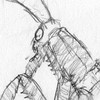HOME | DD
 artbyjrc — Tuxedos of the South - Spheniscids 1
artbyjrc — Tuxedos of the South - Spheniscids 1

#bird #extinct #marine #penguin #sea #spheniscidae #icadyptes #inkayacu #anthropornis #kairuku #crossvallia
Published: 2020-10-02 10:34:39 +0000 UTC; Views: 15112; Favourites: 291; Downloads: 58
Redirect to original
Description
A selection of extinct spheniscids, better known as penguins, to scale.
Having previously covered two groups of unrelated aquatic birds (see Pseudo-penguins of the Pacific - Plotopterids and Penguins of the North - Alcids ) which had convergently evolved flipper-propelled swimming, we now arrive at the best known group. Those dapper little gentlemen, the penguins.
Anybody who has seen a penguin in real life isn't likely to confuse it with another bird. Basic characteristics include flightlessness, upright stance, chunky streamlined body, dark upper body contrasting with a white belly, short legs with webbed feet, long flipper-shaped wings and a sharp beak. Every species is confined to marine habitats in the Southern hemisphere (with only the species on the equatorial Galapagos Islands slightly breaking the rule). Of course if we are talking about the past then there was one recently extinct species which ticked most of these boxes and that was the original 'penguin', better known as the Great Auk. European explorers were familiar with the flightless seabird of the north, and when they were discovered in the southern seas, the flightless swimming birds were given the repurposed name. However despite the similarities auks are not closely related to penguins. In fact due to being highly specialised for 'flying' underwater, it is not obvious as to which bird group that penguins are closest too. In addition to auks, grebes, pelecaniforms and petrels have all been suggested as possible relatives. Recent genetic analysis has confirming a link with the latter group.
Spheniscids are an old group with the first fossils dating close to the Late Cretaceous/Palaeogene extinction event*. From the Late Paleocene onwards penguins were a dominant predator in the southern oceans, and they grew to very large sizes. Kumimanu from the Palaeocene and several species from the Late Eocene - Palaeeudyptes, Pachydyptes, and Anthropornis, all vie for the largest species known. It is difficult to compare each species as isolated bones are known and proportions differ. These were not a natural group separate from other penguins, rather a succession of different species. While penguins are usually linked to cold climates, this wasn't the case during the reign of the giants. Ice caps would have been absent or at least limited during the Eocene/Oligocene and some species such as Icadyptes flourished in balmy climates on the ancient Peruvian coastline.
Long spear-like beaks are an ancestral feature of early penguins and it is assumed that they employed a different hunting strategy to that used by modern species with broader beaks (exaggerated by the outer rhamphotheca layer). The giant penguin beaks can be incredibly long, up to two-thirds of the skull's length. Neck musculature was strongly developed to resist impacts and it is thought that they used the bill like a spear on larger prey. A bigger body size and robust flippers would have also allowed the giant penguins to dive deeper and remain underwater for longer periods for hunting.
Incredibly fossilised feathers belonging to Inkayacu revealed melanomes of reds and greys, a contrast from the predominately white and black colouration that we typically see in penguins.
Giant penguins declined during the Oligocene, coinciding with the arrival of seals and small toothed whales. However later penguins were able to survive in the niche of much smaller hunters.
* I will revisit the earliest penguins in the next post.
Related content
Comments: 39

👍: 1 ⏩: 1

👍: 0 ⏩: 0

👍: 2 ⏩: 0

👍: 1 ⏩: 1

👍: 1 ⏩: 0

👍: 1 ⏩: 1

👍: 0 ⏩: 0

👍: 1 ⏩: 1

👍: 1 ⏩: 1

👍: 0 ⏩: 0

👍: 2 ⏩: 1

👍: 2 ⏩: 0

👍: 1 ⏩: 0

👍: 1 ⏩: 0

👍: 1 ⏩: 0

👍: 1 ⏩: 1

👍: 0 ⏩: 0

👍: 1 ⏩: 1

👍: 0 ⏩: 1

👍: 1 ⏩: 0

👍: 1 ⏩: 0

Awesome plate! It also got me thinking that it sure is interesting how not once during their evolutionary history do any penguins seem to have ranged into the northern hemisphere (with the slight expectation of the Galápagos penguin, as you mentioned). Theories I’ve heard for this include a lack of suitable habitat in the north without overwhelming predation pressure.
👍: 1 ⏩: 1

👍: 1 ⏩: 0

👍: 1 ⏩: 1

👍: 1 ⏩: 1

👍: 0 ⏩: 1

👍: 1 ⏩: 0

👍: 1 ⏩: 1

👍: 0 ⏩: 1

👍: 1 ⏩: 1

👍: 1 ⏩: 1

👍: 1 ⏩: 1

👍: 1 ⏩: 1

👍: 1 ⏩: 1

👍: 1 ⏩: 0

👍: 1 ⏩: 1

👍: 1 ⏩: 0

















